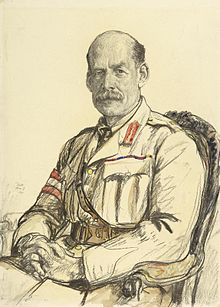Arthur Holland (British Army officer)

Sir Arthur Holland | |
|---|---|
 1917 portrait by Francis Dodd | |
| Birth name | Arthur Edward Aveling Butcher |
| Born | 13 April 1862 Kent, England[1] |
| Died | 7 December 1927 (aged 65) |
| Allegiance | United Kingdom |
| Service | British Army |
| Years of service | 1880–1920 |
| Rank | Lieutenant General |
| Commands | I Corps 1st Division Royal Military Academy, Woolwich |
| Battles / wars | First World War |
| Awards | Knight Commander of the Order of the Bath Knight Commander of the Order of St Michael and St George Distinguished Service Order Member of the Royal Victorian Order Mentioned in Despatches Legion of Honour[2] |
Lieutenant General Sir Arthur Edward Aveling Holland, KCB, KCMG, DSO, MVO (13 April 1862 – 7 December 1927) was a British Army officer and Conservative and Unionist politician.
Military career
[edit]
Born the son of Major General Butcher, Butcher changed his surname to Holland in 1910.[3] Holland was, after graduating from the Royal Military Academy at Woolwich, commissioned into the Royal Artillery in May 1880.[4][5]
He served in the Second Boer War and then became Assistant Military Secretary to the Governor and Commander-in-Chief of Malta in 1903 before holding a similar role at the War Office from 1910.[4] In 1912 he was appointed commandant of the Royal Military Academy, Woolwich.[4]
He also served in the First World War, which began in the summer of 1914, becoming Commander, Royal Artillery (CRA) for the 8th Division, in which capacity he took part in the Battle of Neuve Chapelle in March 1915.[3] In July he became CRA for VII Corps but was only there briefly as in September, after being promoted to the temporary rank of major general,[6] he succeeded Richard Haking as general officer commanding (GOC) of the 1st Division.[3] His major general's rank having been made substantive in January 1916,[7] he continued his war service as CRA for the Third Army from June 1916 and as GOC I Corps from February 1917, upon being made a temporary lieutenant-general.[8]
He retired from the army in 1920, after his rank of lieutenant-general was made permanent.[4][9]
Member of Parliament
[edit]Holland was Member of Parliament for Northampton from 1924 until his death in 1927.[4] The consequent by-election for his seat was won by the Labour candidate Cecil Malone.
Family
[edit]Arthur Holland married Mary Kate Duval; they had one daughter.[3] He died in 1927 and was interred in Greenwich Cemetery.[10]
References
[edit]- ^ "Life story: Arthur Edward Aveling Holland | Lives of the First World War". livesofthefirstworldwar.iwm.org.uk.
- ^ "No. 31150". The London Gazette (Supplement). 28 January 1919. p. 1445.
- ^ a b c d Obituary: General Sir Arthur Holland MP Archived 4 March 2016 at the Wayback Machine The Times, 8 December 1927
- ^ a b c d e Liddell Hart Centre for Military Archives
- ^ "No. 24848". The London Gazette. 28 May 1880. p. 3221.
- ^ "No. 29319". The London Gazette (Supplement). 5 October 1915. p. 9871.
- ^ "No. 12894". The Edinburgh Gazette. 17 January 1916. p. 86.
- ^ "No. 29996". The London Gazette. 23 March 1917. p. 2862.
- ^ "No. 31092". The London Gazette (Supplement). 31 December 1918. p. 13.
- ^ "Greenwich Cemetery". London Gardens Online. Archived from the original on 14 March 2016. Retrieved 14 March 2016.